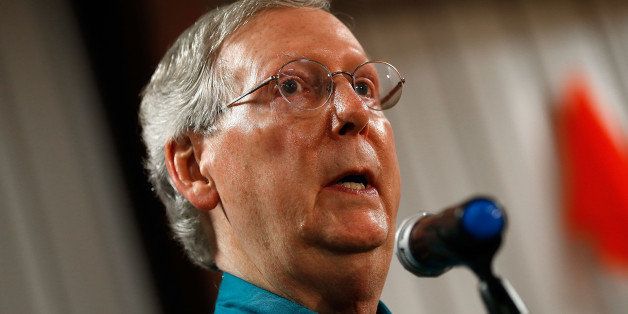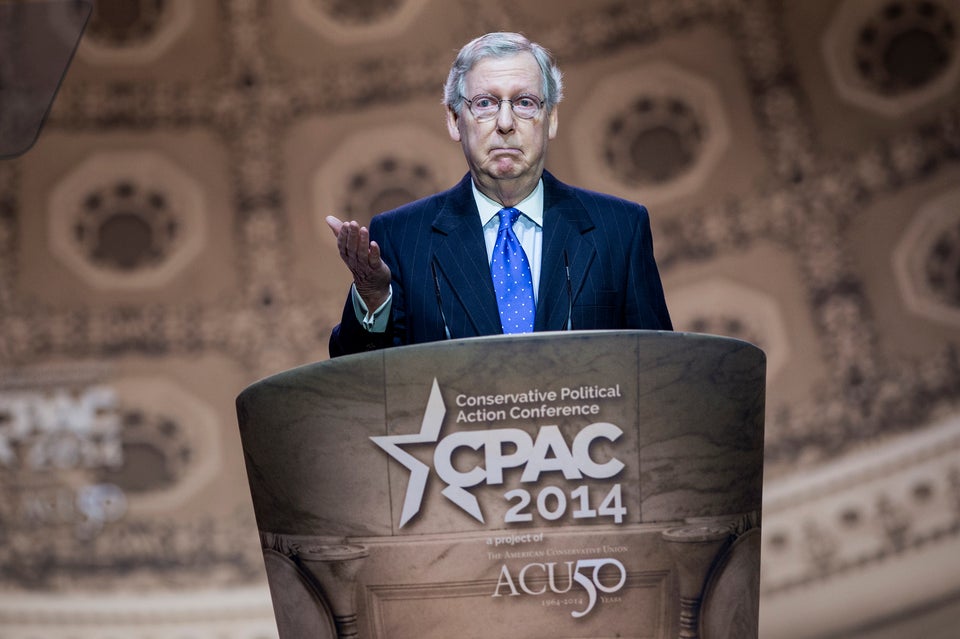
This story was published by The Center for Public Integrity, a nonprofit, nonpartisan investigative news organization in Washington, D.C.
Don’t believe for a bluegrass minute that Senate Minority Leader Mitch McConnell, R-Ky., is taking his challenge from Democrat Alison Lundergan Grimes lightly.
During the week following Labor Day, McConnell’s campaign aired, on average, one TV ad every five minutes — about 2,200 ads in all, according to a Center for Public Integrity review of data provided by Kantar Media/CMAG, an advertising tracking service.
That’s roughly twice as many ads as Grimes’ campaign aired during the same period and more than any U.S. Senate candidate nationwide.
But for Republicans, Kentucky’s big-money Senate contest is an anomaly during a week that saw Democrats and their allies produce more TV spots in most battleground states.
It’s the latest indication that Democrats, who have long feared being outgunned this cycle, are willing to spend whatever’s necessary to prevent the GOP from seizing the six Senate seats it needs in November to win a Senate majority.
During the week following Labor Day, Democrats and their allies aired significantly more TV ads in Alaska, Georgia, Michigan and North Carolina, according to estimates from Kantar Media/CMAG.
In Arkansas, Colorado, Iowa and Louisiana, Democrats and their allies also edged out their rivals by narrower margins, airing less than 10 percent more TV ads than conservatives in each state during the week following Labor Day.
To see a graph of last week's TV ads in the 2014 battle for the Senate, visit the Center for Public Integrity.
Much of this air cover came from the Democratic Senatorial Campaign Committee, Senate Majority PAC and Vote Vets Action Fund.
These three groups that exemplify the range of political players behind the advertising barrages in battleground states this year.
The DSCC is an official arm of the Democratic Party. It discloses its funders and can only accept contributions no larger than $32,400 per donor per year.
Senate Majority PAC and Vote Vets Action Fund, however, don’t have a limit on the size of donations they may receive. As a super PAC, Senate Majority PAC discloses its donors’ name, while Vote Vets Action Fund, as a “social welfare” nonprofit organized under Sec. 501(c)(4) of the U.S. tax code, does not. Both types of groups have flourished in the wake of the U.S. Supreme Court’s Citizens United v. Federal Election Commission ruling that loosened campaign spending rules for companies.
Generally, candidates themselves may only accept $2,600 per donor per election, with a primary and general election counting as separate elections.
To view a graph of total TV ads in the 2014 battle for the Senate through Sept. 8, go to the Center for Public Integrity.
Super PACs are making their marks in other Senate races, too.
In Virginia, for instance, incumbent Democratic Sen. Mark Warner is favored to win re-election but is being challenged by former Republican National Committee Chairman Ed Gillespie.
But Warner’s allies aren’t taking chances, as a pro-Democratic super PAC called Virginia Progress PAC has roared to life, airing roughly 630 TV ads during the week following Labor Day — about 40 percent of all ads in the state during this period.
Virginia Progress PAC has raised about $1.7 million this year, according to Federal Election Commission filings. Its largest donor? A limited liability company called Alcantara LLC, which, as the Huffington Post first reported, is owned by tech entrepreneur Michael Saylor, who is also Warner’s close friend.
Meanwhile in New Hampshire, a quixotic super PAC that advocates for campaign finance reform failed to propel favored candidate Jim Rubens to victory in a Republican primary that former U.S. Sen. Scott Brown of Massachusetts easily won. He now faces incumbent Democratic Sen. Jeanne Shaheen in what’s likely to be a close race.
Mayday PAC argued it helped Rubens finish second and thrust campaign finance reform into the race’s spotlight. But Mayday PAC leader Lawrence Lessig acknowledged afterward, “We lost. Badly.”
According to FEC records, the super PAC spent $1.6 million overall on various messaging to do so — or about $59 per vote Rubens received. That includes 70 TV ads — about one-fifth the number of ads Brown’s campaign aired — during the week after Labor Day, according to Kantar Media/CMAG. Rubens himself did not air TV ads.
In the past week, Kansas also emerged as potential battleground state in the fight for control of the Senate.
Democrat Chad Taylor dropped out of the race on Sept. 3, a move that some observers say could boost independent Greg Orman’s chances of defeating incumbent Republican Sen. Pat Roberts.
In the week following Labor Day, Orman’s campaign aired about 450 ads, while Roberts’ campaign aired zero, according to Kantar Media/CMAG.
To date, the better-funded Roberts has aired more than 3,800 ads, while Orman has aired about 2,700, including ads during Roberts’ heated GOP primary in August.
Dave Levinthal contributed to this report.
